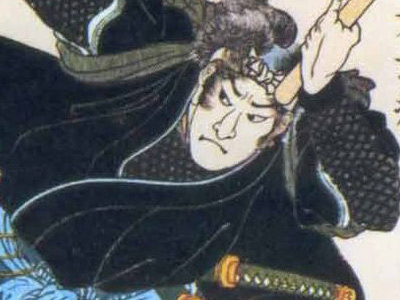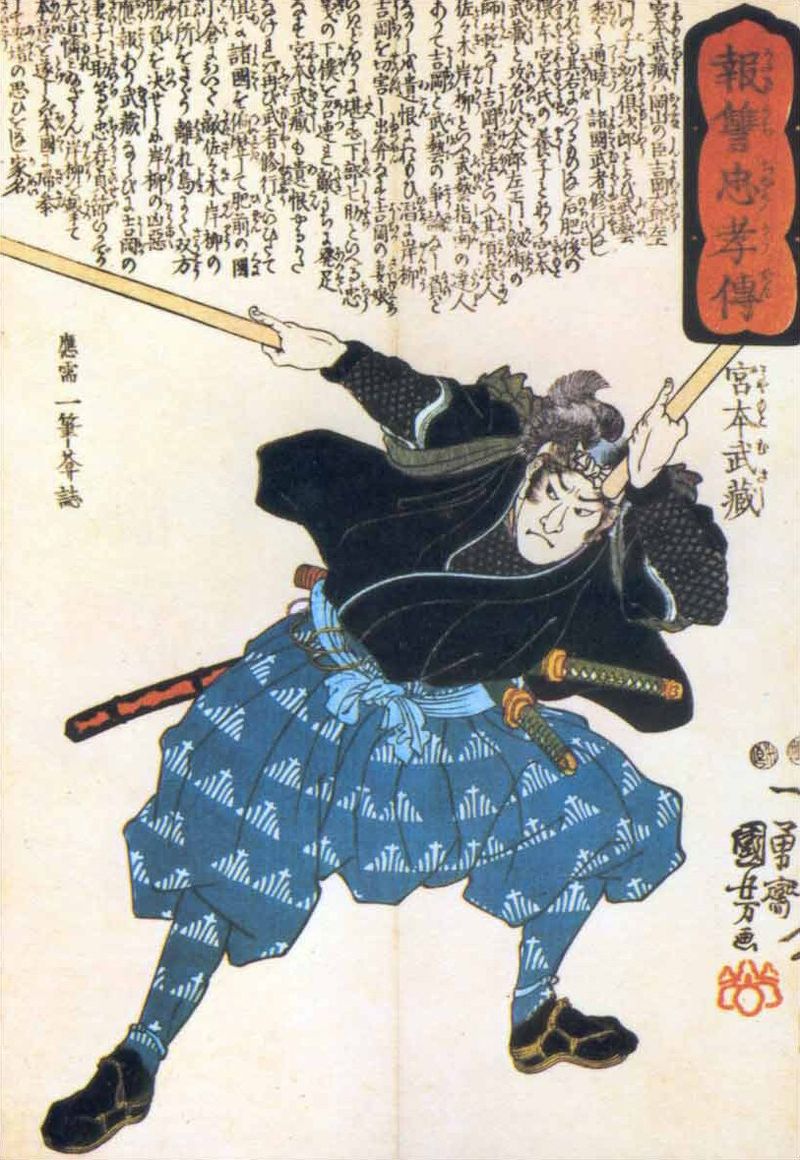Miyamoto Musashi (1584-1645)
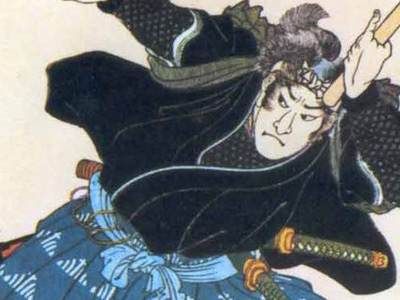
Biography of Miyamoto Musashi (宮本 武蔵)
The details of Miyamoto Musashi's early life are difficult to verify. Musashi himself simply states in The Book of Five Rings that he was born in Harima Province. Niten Ki (an early biography of Musashi) supports the theory that Musashi was born in 1584: "[He] was born in Banshū, in Tenshō 12 [1584], the Year of the Monkey." The historian Kamiko Tadashi, commenting on Musashi's text, notes: "[...]Munisai was Musashi's father...he lived in Miyamoto village, in the Yoshino district [of Mimasaka Province]. Musashi was most probably born here." His childhood name was Bennosuke (弁之助).
Musashi gives his full name and title in The Book of Five Rings as Shinmen Musashi-no-Kami Fujiwara no Genshin (新免武蔵守藤原玄信). His father, Shinmen Munisai (新免無二斎) was an accomplished martial artist and master of the sword and jutte (also jitte). Munisai, in turn, was the son of Hirata Shōgen (平田将監), a vassal of Shinmen Iga no Kami, the lord of Takayama Castle in the Yoshino district of Mimasaka Province. Hirata was relied upon by Lord Shinmen and so was allowed to use the Shinmen name. As for "Musashi," Musashi no Kami was a court title, making him the nominal governor of Musashi province. "Fujiwara" was the lineage from which Musashi claimed nominal descent.
Munisai and Musashi's birth date
Munisai's tomb says he died in 1580, which obviously conflicts with the accepted birth date of 1584 for Musashi. Further muddying the waters, according to the genealogy of the extant Miyamoto family, Musashi was born in 1582. Kenji Tokitsu has suggested that the accepted birth date of 1584 for Musashi is wrong, as it is primarily based on a literal reading of the introduction to The Book of Five Rings where Musashi states that the years of his life "add up to 60" (yielding the twelfth year of the Tensho era, or 1584, when working backwards from the well-documented date of composition), when it should be taken in a more literary and imprecise sense, indicating not a specific age but merely that Musashi was in his sixties when he wrote it.
Because of the uncertainty centering on Munisai (when he died, whether he was truly Musashi's father, etc.), Musashi's mother is known with even less confidence. Here are a few possibilities:
- Munisai's tomb was correct. He died in 1580, leaving two daughters and son Iori; his wife adopted a recently born child, from the Akamatsu clan, intended to succeed Munisai at his jitte school. Omasa, Munisai's widow, was not Musashi's biological mother.
- The tomb was wrong. Munisai lived a good deal longer, later than 1590 possibly. Musashi, then, was born to Munisai's first wife, Yoshiko (daughter to Bessho Shigeharu, who formerly controlled Hirafuku village until he lost a battle in 1578 to Yamanaka Shikanosuke). Munisai divorced her after Musashi's birth, whereupon she decamped for her father's house, leaving Musashi with Munisai. Musashi grew up treating Munisai's second wife, Omasa (daughter to Lord Shinmen) as his mother. This second scenario is laid out in an entry to the Tasumi family's genealogy. The daughter of Bessho Shigeharu first married Hirata Muni and was divorced from him a few years later. After that she married Tasumi Masahisa. The second wife of Tasumi Masahisa was the mother of Miyamoto Musashi. Musashi's childhood name was Hirata Den. During his childhood, he went to Hirafuku to find his real mother. He moved in with the Tasumi family.
- A variant of this second theory is based on the fact that the tombstone states that Omasa gave birth to Musashi on 4 March 1584, and died of it. Munisai then remarried to Yoshiko. They divorced, as in the second theory, but Yoshiko took Musashi, who was 7 at the time, with her, and married Tasumi Masahisa.
- Kenji Tokitsu prefers to assume a birth date of 1581, which avoids the necessity of assuming the tombstone to be erroneous (although this poses the problem of from whom then Musashi received the transmission of the family martial art).
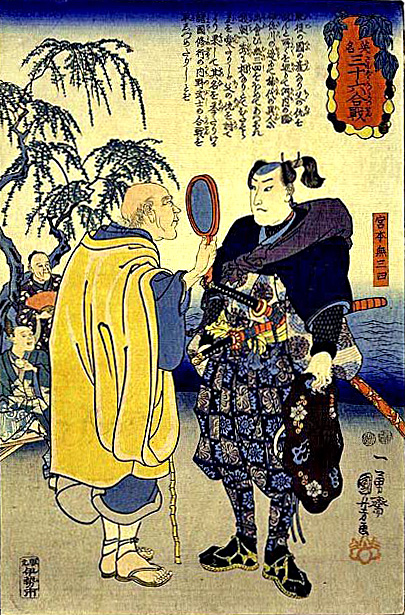
Upbringing
Regardless of the truth about Musashi's ancestry, when Musashi was seven years old, the boy was raised by his uncle, Dorinbo (or Dorin), in Shoreian temple, three kilometers (~1.8 mi.) from Hirafuku. Both Dorin and Musashi's uncle by marriage, Tasumi, educated him in Buddhism and basic skills such as writing and reading. This education is possibly the basis for Yoshikawa Eiji's fictional education of Musashi by the historical Zen monk Takuan. He was apparently trained by Munisai in the sword, and in the family art of the jutte. This training did not last for a very long time, as in 1589, Munisai was ordered by Shinmen Sokan to kill Munisai's student, Honiden Gekinosuke. The Honiden family was displeased, and so Munisai was forced to move four kilometers (~2.5 mi.) away to the village of Kawakami.
In 1592, Munisai died, although Tokitsu believes that the person who died at this time was really Hirata Takehito.
Musashi contracted eczema in his infancy, and this adversely affected his appearance. Another story claims that he never took a bath because he did not want to be surprised unarmed. While the former claim may or may not have some basis in reality, the latter seems improbable. An unwashed member of the warrior caste would not have been received as a guest by such houses as Honda, Ogasawara, and Hosokawa. These and many other details are likely embellishments that were added to his legend, or misinterpretations of literature describing him.
His father's fate is uncertain, but it is thought that he died at the hands of one of Musashi's later adversaries, who was punished or even killed for treating Musashi's father badly. However, there are no exact details of Musashi's life, since Musashi's only writings are those related to strategy and technique.
HISTORY
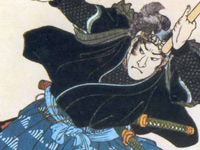
RESOURCES
This article uses material from the Wikipedia article "Miyamoto Musashi", which is released under the Creative Commons Attribution-Share-Alike License 3.0.
© Stories Preschool. All Rights Reserved.
